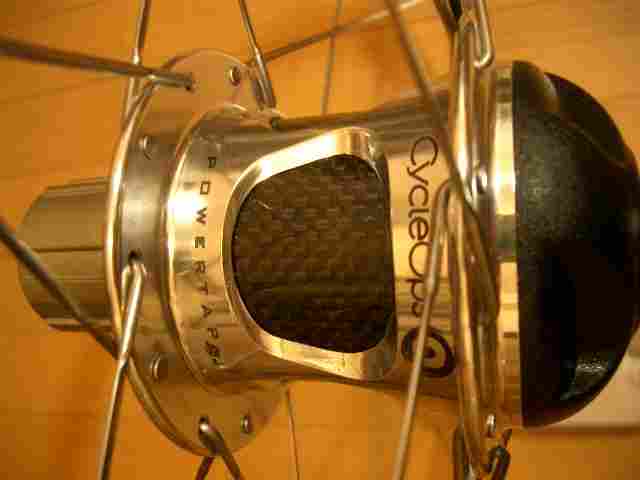http://www.physfarm.com/CdA%20Test-FGF~v2.xls
あとはいい場所を見つけて走るだけ!
7/28/2006
Re: Pursuit preparation
Re: Pursuit preparation
覚えとして貼っておこう.
-----------------
acoggan
Registered User
 Re: Pursuit preparation
Re: Pursuit preparation
My recommendation is that people use data from tests >~3 min but <~30 min in duration. Here's why: As you know, the critical power paradigm assumes a linear relationship between work and time, with the slope of this relationship representing one's critical power, i.e., a power that "...can be maintained for a very long time w/o fatiguing." In fact, critical power can, in theory, be maintained forever. Of course, no exercise intensity can be maintained forever (indeed, as I like to joke even resting metabolic rate can only be maintained for one's lifetime), which immediately reveals one of the limitations of this approach: the data don't really conform to a perfectly linear relationship, but instead will fall progressively further and further below the line-of-best-fit as the duration is extended. However, as long as you limit yourself to tests <~30 min in duration, you'll get a good fit to the data, and the calculated critical power will be highly reproducible (anaerobic work capacity somewhat less so). OTOH, if you include points beyond that time, you will tend to obtain a lower estimate of your critical power, and will tend to overestimate your anaerobic work capacity.
That explains the choice of the upper limit...what about at the short end of things? Again, the selection of 3 min is based on trying to minimize another limitation of the model, albeit one that isn't so intuitively obvious. Specifically, some inherent assumptions of the critical power paradigm are that 1) all of one's anaerobic work capacity will be fully expended during a particular effort (test), and 2) aerobic energy production is fully "online" from the very instant that exercise begins. In fact, neither of this is really true: it generally takes 1.5+ min to fully utilize all of your anaerobic work capacity, and VO2 won't reach a true steady-state until at least that long, and in fact usually longer. The consequence of these violations of the assumptions of the critical power model is that you can't do as much work in only a few minutes as the model predicts, such that those points, too, will tend to fall below the regression line. If you choose to include them anyway, you will obtain a higher estimate of your critical power, and a lower estimate of your anaerobic work capacity.
(BTW, after arriving at the conclusion that tests of the above duration were really best - despite the fact that tests of 1-10 min are routinely used in scientific studies - I subsequently came across a published paper that presented the same recommendation. Unfortunately, the literature on critical power is quite large, so I can't find the latter paper for you at the moment!)
--------------------
覚えとして貼っておこう.
-----------------
acoggan
Registered User
Quote:
| Originally Posted by Alex Simmons What time periods are we using for the monod model? I have 1, 3, 5 & 20 min MMPs in there. I find this choice can vary AWC calcs considerably. |
That explains the choice of the upper limit...what about at the short end of things? Again, the selection of 3 min is based on trying to minimize another limitation of the model, albeit one that isn't so intuitively obvious. Specifically, some inherent assumptions of the critical power paradigm are that 1) all of one's anaerobic work capacity will be fully expended during a particular effort (test), and 2) aerobic energy production is fully "online" from the very instant that exercise begins. In fact, neither of this is really true: it generally takes 1.5+ min to fully utilize all of your anaerobic work capacity, and VO2 won't reach a true steady-state until at least that long, and in fact usually longer. The consequence of these violations of the assumptions of the critical power model is that you can't do as much work in only a few minutes as the model predicts, such that those points, too, will tend to fall below the regression line. If you choose to include them anyway, you will obtain a higher estimate of your critical power, and a lower estimate of your anaerobic work capacity.
(BTW, after arriving at the conclusion that tests of the above duration were really best - despite the fact that tests of 1-10 min are routinely used in scientific studies - I subsequently came across a published paper that presented the same recommendation. Unfortunately, the literature on critical power is quite large, so I can't find the latter paper for you at the moment!)
--------------------
7/23/2006
Human Power Meter (HPM)
なにはともあれFloyd Landis,TDF優勝おめでとう! 特に17ステージ,powermeter装着車両がTDFの山岳ステージを駆け抜ける映像がTVで流れてくるなんて思っていなかった.
#しかもSRMじゃなくて,Powertap!!
ところが最後の正念場,19ステージITT,噂のZIPP 999 Disk w/PowerTapを使ってなかった... 何故? よく海外のフォーラムとかで,「パワーも心拍数もレース中には見ない」「LCDにテープをはって,後で解析するだけ」といった意見を見る.では,ペーシングはどうするのか.やはりプロだから,カンで片付くのか.ためしにやってみよう.
テスト場所:定峰峠(埼玉県,距離約5km)
テスト方法:同じ峠で,日を変えて2回の試走を行った.バイクは2回とも同じで,Powertapでパワー,スピード,ケイデンスを記録した.試走1回目はメータをのパワー値を見ながらペーシングを行い,試走2回目はメータがMax値のみ表示するように設定して,ペーシングに使えないようにした.
備考:2回とも弱雨路面ウェット,体感できる風なし.
タイヤ銘柄,タイヤ空気圧は2回とも同じ.
2回目は車体を300gくらい軽量化した.
2回目は後輪のチューブにラテックスを使った.
結果:
 試走2 ⇒ 平均266W,タイム14:07
試走2 ⇒ 平均266W,タイム14:07
考察:
試走1と試走2では,全く同じ平均出力となった.ペースの山谷の少なさという観点では,むしろ試走2の方が良いように見える.ただ,筆者はこのコースを何度も走っているので,ある程度体がペースを覚えているのかもしれない.また,このコースは5kmしかなく,ペーシングの良し悪しが平均出力に影響し難い可能性もある.尚,2回の試走の両方とも,最後はもがいたつもりなので,手加減したということはない.同じ平均出力でも,タイムは,装備の違いから僅かに(1%程度)向上している.
結論:
人間は計器なしでも自律的にペーシングを行うことが可能な程度の,Human Power Meter (HPM)機構をもっており,そしてそれはパワーを見ながらのトレーニングによって強化できる可能性がある.だが所詮「カン」なので,コンディショニングその他によって影響される可能性は否定できない(e.g., テーパリング後,脚が妙にフレッシュなときは楽にパワーを出せてしまう)ため,その用途は限られる.
#しかもSRMじゃなくて,Powertap!!
ところが最後の正念場,19ステージITT,噂のZIPP 999 Disk w/PowerTapを使ってなかった... 何故? よく海外のフォーラムとかで,「パワーも心拍数もレース中には見ない」「LCDにテープをはって,後で解析するだけ」といった意見を見る.では,ペーシングはどうするのか.やはりプロだから,カンで片付くのか.ためしにやってみよう.
テスト場所:定峰峠(埼玉県,距離約5km)
テスト方法:同じ峠で,日を変えて2回の試走を行った.バイクは2回とも同じで,Powertapでパワー,スピード,ケイデンスを記録した.試走1回目はメータをのパワー値を見ながらペーシングを行い,試走2回目はメータがMax値のみ表示するように設定して,ペーシングに使えないようにした.
備考:2回とも弱雨路面ウェット,体感できる風なし.
タイヤ銘柄,タイヤ空気圧は2回とも同じ.
2回目は車体を300gくらい軽量化した.
2回目は後輪のチューブにラテックスを使った.
結果:
 試走2 ⇒ 平均266W,タイム14:07
試走2 ⇒ 平均266W,タイム14:07考察:
試走1と試走2では,全く同じ平均出力となった.ペースの山谷の少なさという観点では,むしろ試走2の方が良いように見える.ただ,筆者はこのコースを何度も走っているので,ある程度体がペースを覚えているのかもしれない.また,このコースは5kmしかなく,ペーシングの良し悪しが平均出力に影響し難い可能性もある.尚,2回の試走の両方とも,最後はもがいたつもりなので,手加減したということはない.同じ平均出力でも,タイムは,装備の違いから僅かに(1%程度)向上している.
結論:
人間は計器なしでも自律的にペーシングを行うことが可能な程度の,Human Power Meter (HPM)機構をもっており,そしてそれはパワーを見ながらのトレーニングによって強化できる可能性がある.だが所詮「カン」なので,コンディショニングその他によって影響される可能性は否定できない(e.g., テーパリング後,脚が妙にフレッシュなときは楽にパワーを出せてしまう)ため,その用途は限られる.
登録:
投稿 (Atom)


